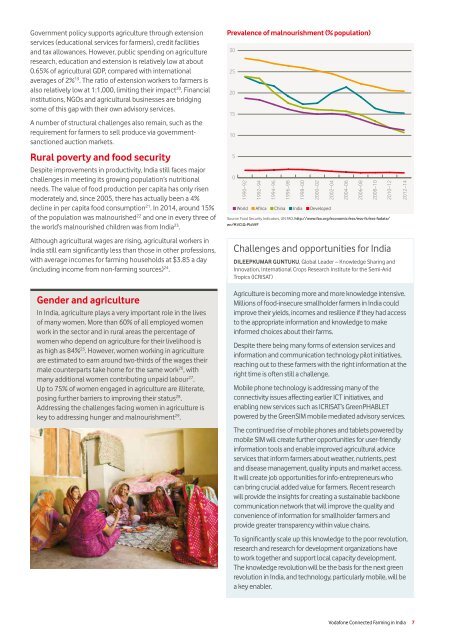Connected-Farmers
Connected-Farmers
Connected-Farmers
Create successful ePaper yourself
Turn your PDF publications into a flip-book with our unique Google optimized e-Paper software.
Government policy supports agriculture through extension<br />
services (educational services for farmers), credit facilities<br />
and tax allowances. However, public spending on agriculture<br />
research, education and extension is relatively low at about<br />
0.65% of agricultural GDP, compared with international<br />
averages of 2% 19 . The ratio of extension workers to farmers is<br />
also relatively low at 1:1,000, limiting their impact 20 . Financial<br />
institutions, NGOs and agricultural businesses are bridging<br />
some of this gap with their own advisory services.<br />
A number of structural challenges also remain, such as the<br />
requirement for farmers to sell produce via governmentsanctioned<br />
auction markets.<br />
Rural poverty and food security<br />
Despite improvements in productivity, India still faces major<br />
challenges in meeting its growing population’s nutritional<br />
needs. The value of food production per capita has only risen<br />
moderately and, since 2005, there has actually been a 4%<br />
decline in per capita food consumption 21 . In 2014, around 15%<br />
of the population was malnourished 22 and one in every three of<br />
the world’s malnourished children was from India 23 .<br />
Although agricultural wages are rising, agricultural workers in<br />
India still earn significantly less than those in other professions,<br />
with average incomes for farming households at $3.85 a day<br />
(including income from non-farming sources) 24 .<br />
Prevalence of malnourishment (% population)<br />
30<br />
25<br />
20<br />
15<br />
10<br />
5<br />
0<br />
1990–92<br />
1992–94<br />
1994–96<br />
1996–98<br />
1998–00<br />
2000–02<br />
World Africa China India Developed<br />
Source: Food Security Indicators, UN FAO, http://www.fao.org/economic/ess/ess-fs/ess-fadata/<br />
en/#.VClQ-PldVfF<br />
Challenges and opportunities for India<br />
DILEEPKUMAR GUNTUKU, Global Leader – Knowledge Sharing and<br />
Innovation, International Crops Research Institute for the Semi-Arid<br />
Tropics (ICRISAT)<br />
2002–04<br />
2004–06<br />
2006–08<br />
2008–10<br />
2010–12<br />
2012–14<br />
Gender and agriculture<br />
In India, agriculture plays a very important role in the lives<br />
of many women. More than 60% of all employed women<br />
work in the sector and in rural areas the percentage of<br />
women who depend on agriculture for their livelihood is<br />
as high as 84% 25 . However, women working in agriculture<br />
are estimated to earn around two-thirds of the wages their<br />
male counterparts take home for the same work 26 , with<br />
many additional women contributing unpaid labour 27 .<br />
Up to 75% of women engaged in agriculture are illiterate,<br />
posing further barriers to improving their status 28 .<br />
Addressing the challenges facing women in agriculture is<br />
key to addressing hunger and malnourishment 29 .<br />
Agriculture is becoming more and more knowledge intensive.<br />
Millions of food-insecure smallholder farmers in India could<br />
improve their yields, incomes and resilience if they had access<br />
to the appropriate information and knowledge to make<br />
informed choices about their farms.<br />
Despite there being many forms of extension services and<br />
information and communication technology pilot initiatives,<br />
reaching out to these farmers with the right information at the<br />
right time is often still a challenge.<br />
Mobile phone technology is addressing many of the<br />
connectivity issues affecting earlier ICT initiatives, and<br />
enabling new services such as ICRISAT’s GreenPHABLET<br />
powered by the GreenSIM mobile mediated advisory services.<br />
The continued rise of mobile phones and tablets powered by<br />
mobile SIM will create further opportunities for user-friendly<br />
information tools and enable improved agricultural advice<br />
services that inform farmers about weather, nutrients, pest<br />
and disease management, quality inputs and market access.<br />
It will create job opportunities for info-entrepreneurs who<br />
can bring crucial added value for farmers. Recent research<br />
will provide the insights for creating a sustainable backbone<br />
communication network that will improve the quality and<br />
convenience of information for smallholder farmers and<br />
provide greater transparency within value chains.<br />
To significantly scale up this knowledge to the poor revolution,<br />
research and research for development organizations have<br />
to work together and support local capacity development.<br />
The knowledge revolution will be the basis for the next green<br />
revolution in India, and technology, particularly mobile, will be<br />
a key enabler.<br />
Vodafone <strong>Connected</strong> Farming in India 7


